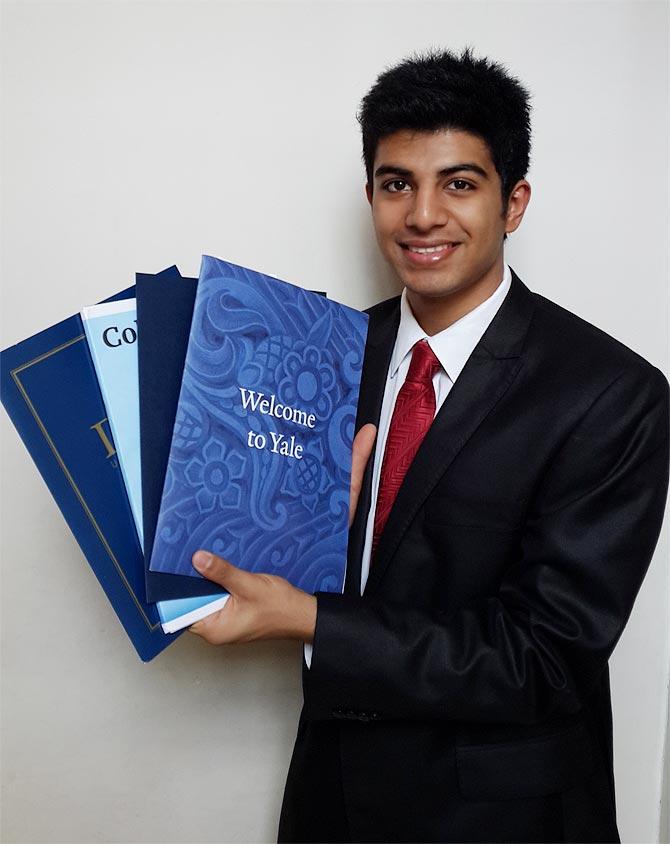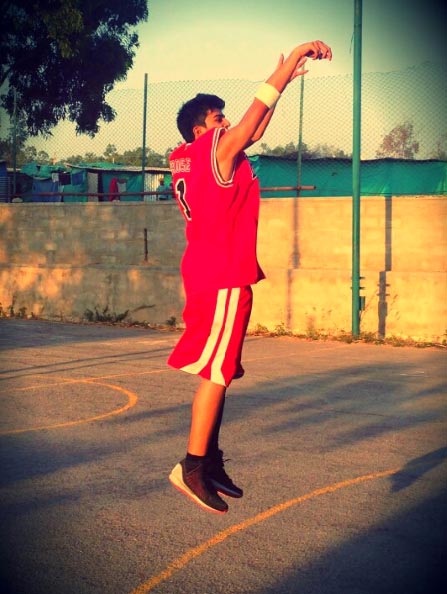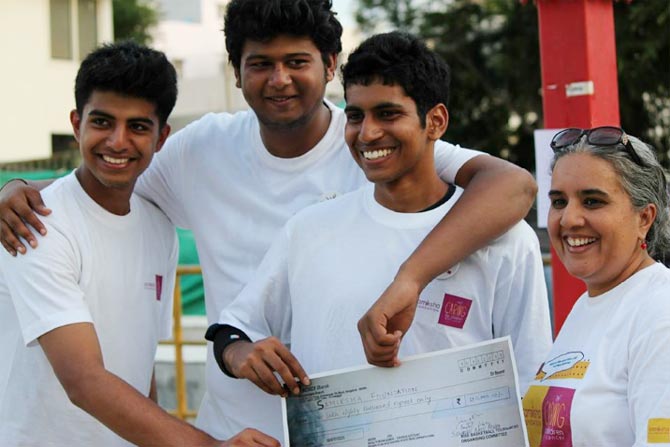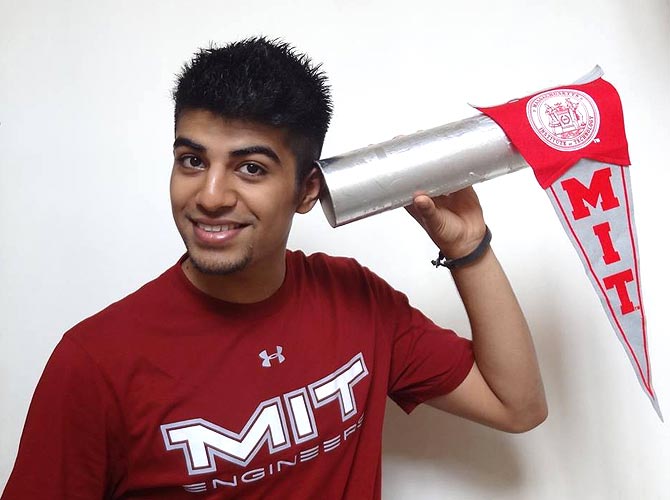 | « Back to article | Print this article |
What this MIT reject did in his break year will surprise you
MIT rejected Sudhanshu Mishra's application for their undergraduate programme in computer science last year.
How then did he manage to turn this rejection to his advantage and bag scholarship offers worth upto Rs 36 lakh from a dozen leading international universities this year?
Read on:
Sudhanshu Mishra was 17 when he first applied to the Massachusetts Institute of Technology in the United States of America for an undergraduate programme in computer science.
Despite having a strong academic profile -- he'd scored an aggregate of 93.2 per cent in the class 12 CBSE board examination and got the highest marks in Physics -- 98 out of 100 -- MIT turned down Mishra.
Unsure of what to do next, the student of AECS Magnolia Maaruti Public School, Bangalore, decided to take a one-year break.
Mishra's parents -- his father is an engineer from IIT-Kharagpur who's pursuing his PhD from the International Institute of Information Technology, Bangalore, and mother is a doctor practising at St John's Medical College in Bangalore – were not very happy with his choice of a break year.
But Mishra was adamant.
One year later, of the 13 applications he sent to the best colleges in the US and UK, Mishra was able to bag 12 scholarship offers (ranging between Rs 27 to Rs 36 lakh) from top ranked global institutes such as Yale, MIT, Cambridge University, Columbia University, Duke University, University of California, Berkeley, University of California, Los Angeles, Carnegie Mellon University, Harvey Mudd College, Rice University and Georgia Institute of Technology. The only college he did not crack was Harvard.
So, how did he do it?
More importantly, how did he convince the MIT panel to reconsider his application?
Here he explains what he did in the year he took off and how he prepared for the next round of applications.
Why did you take a break?
At 17, a lot of people like me take a break because they are not sure of what they want to do.
I wanted to find out what mattered the most to me and pursue that with all my heart.
I wanted to play basketball, become an entrepreneur and at the same time do something for society.
I wasn't sure how to do all this or in what order to do them.
A break year was the best way to find out.
Please click NEXT to continue reading...
'I wanted to be in the Under-18 state basketball team'
Did you manage to accomplish them all?
Almost all of them, except one.
I wanted to be in the Under-18 state basketball team.
I made it to the Top 50 in the qualifying round after competing against 400 odd players under the age of 18 but I did not make it to the finals.
What did you do during the break year?
In July 2013, I started applying to several Advanced Placement papers. APs are specialised courses certified by the College Board, a US-based educational association and made available to high school students internationally.
The AP scores are valid in the United States of America and Canada.
Between July and December 2013, I took APs in core sciences like chemistry, physics, calculus, microeconomics and psychology to name a few.
After that, I applied to the Student Expedition Programme (STEP) in Bangalore. There I worked with a team under Dr Venkatesh Thuppil of the biochemistry and biophysics department of St Johns Medical College in Bangalore researching the effect of lead poisoning in the plumbing system in India.
The findings were published in the Journal of the Krishna Institute of Medical Sciences University, in January 2014.
I was also affected by the increasing number of ATM thefts in Bangalore and wanted to do something about it.
So I invented and patented an Android-based security system that if placed inside the ATM would trigger off an SMS-based alarm in times of emergency.
I also started a campaign titled 'Share Your Books' through which I was able to collect and distribute over 3,000 books from 1000 contributors across Bangalore which I donated to Sri Ramakrishna Mission in Bangalore.
Please click NEXT to continue reading...
'They made me solve 20 math problems in less than an hour'
Were you always an academically bright student?
I'd score above 90 per cent but there were definitely better students in my class.
During my JEE preparatory class, I met students who were far more bright and talented than me. I would call myself an above average student.
What did you do the second time round that your application for MIT was successful?
After my MIT application was rejected I consulted a private counsellor who told me what my flaws were.
Having a strong academic profile alone wasn't enough. I had to explain my purpose of choosing both the programme and the institute.
He asked me to write five different essays and he picked the best. Then he pointed out the mistakes and made me rewrite it another five times before I finally sent it.
The whole process took me a little over three months, but since I started in advance I could finish it well on time.
I increased my chances by applying to more than one university. Fortunately, I got selected by all the universities I applied to, except Harvard.
What questions were asked in the admission interview?
The Statement of Purpose and the essay are crucial to any overseas application.
You have to be really sure why you applied to a particular university and also explain it in your application.
If you manage to get someone else to write you an essay, you still have to face a panel in the interview rounds.
The panellists were keen to know why I wanted to study at their institute and what was it that I intended to accomplish through the programme.
Most of the interviews took place over the phone and through Skype. But I was asked to fly down to Cambridge for that interview.
They made me solve 20 math problems in less than an hour and the difficulty level kept increasing gradually.
Please click NEXT to continue reading...
'I want to use my education to do something good and useful for society'
How important is academic performance in cracking these institutions?
Besides the essay and interviews, most US institutions were interested in my academic profile.
It helped that I had a fairly good academic record --10 CGPA in class 10, which is the highest and 93.2 per cent aggregate in class 12.
I'd scored 2310 out of 2400 in my Scholastic Aptitude Test, which put me in the league of 99 percentilers. I guess that really nailed it for me.
What was the most challenging question and how did you tackle it?
One of the most commonly asked questions was: What matters the most to you?
It was first asked at Columbia and soon I was facing similar questions at all other universities.
The nature of this question is so spontaneous that no matter how much you prepare, you still have to think it through before you attempt it.
For an 18-year-old it is difficult to come up with a quick answer, particularly because we have a lot going on inside our minds about the tall things we’d like to accomplish. More often than not, we are not sure of what we really want to do; we are still learning.
I took a good two minutes or perhaps more before I said: I've grown up in a country where good education, health and sanitation are at a premium and I want to address them. I want to use my education to do something good and useful for society, to make it better.
After having said it for the first time, I realised the purpose of my life and education.
What is the panel essentially looking for in candidates?
Certainly, they are looking for a candidate with good academic credentials. But at the same time, they look at your holistic profile and that includes your extra-curriculars.
If you are going to say you like dancing, singing and music, you will have to reason why and how you are going to make use of your abilities.
I had participated in Rise, a national level basketball challenge commended by NBA India and Basketball Federation of India to raise funds for cancer patients.
We were able to raise about Rs 1,80,000 through the initiative. So, I wasn't just saying I love basketball; I was also doing something with it.
Please click NEXT to continue reading...
'Learn from your mistakes and turn them in your favour'
What's the main thing you learnt from this experience?
It's an unfortunate truth that sometimes hard work and passion can also betray you. My childhood dream was to play basketball for the country.
But after making it to the Top 50, I was turned down by the Karnataka state under-18 team.
I have realised that rejections and failures are part of life. It's up to you to learn from your mistakes and turn them in your favour.
You may sulk and complain, but it won't get you anywhere. You have to motivate yourself and rise up again.
Don't be sidetracked, don't give up, yet.
What are your future plans?
I have decided to complete my graduation in computer science from the Massachusetts Institute of Technology.
I am also talking to a couple of buyers who are interested in commercialising my Android-based security system that would bring down ATM thefts.
What’s your advice to those who want to pursue higher education abroad?
- Don't try to do everything at once. Don't overestimate the importance of extra curricular activities and fill up your CV with that. Academic proficiency continues to be a major influencing factor at most institutions like Cambridge.
- Spend considerable amount of time in writing your essay. It has to be more about you, your life goals and what you intend to do at the chosen institution than just about your achievements and what you've already done.
- Always keep up with the deadlines. Plan in advance and check every document more than once before sending it. With every rejected application, not only do you lose time, you also lose an opportunity.




